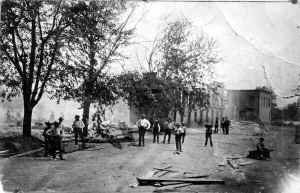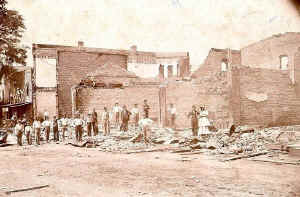
1886 Bonaparte Fire |

1894 Bonaparte Fire |
| |
|
| [click
photo for larger view] |
The following record of fires in Bonaparte was compiled a number of years ago by T. C. Pender and O. J. Coolidge, both now deceased. This record makes interesting centennial history.
1852 – The first fire of which any record is known, occurred in 1852, being a one story frame building situated on Front street in Block one, filled with a stock of merchandise owned by John McCausland. Building and contents entirely destroyed.
1856 – Saw mill owned by Dr. Cresap destroyed.
1860 – A one story frame school house was totally destroyed in the winter of 1860. The building was situated in Block 7 on West street. The school was taught by a man named Lyon.
1863 – On Sunday, July 5th, 1863 the Meek Woolen Mills was totally destroyed.
1875 – The Potter shop, a two story frame building owned by Hanback and Wilson totally destroyed.
1886 – March 2, the residence of John Stirling, Jr., on Main Street, totally destroyed.
1886 – July 16, occurred the first big fire since the burning of the Woolen Mills. In this 14 buildings were totally destroyed, as follows: Theo Bradford livery stable, ice house and office building, two story frame owned by John H. Cresap and occupied by C. H. Coolidge as a billiard hall; two story frame building and ware house owned by Mrs. C. A. Troutman and occupied by W. C. Patten's bakery; one story frame owned by Martha W. Coolidge and occupied by Ira Brown with a carpentry shop; one story frame owned by Dr. B. P Blackmer; one story frame owned by F. A. Steinmeyer and occupied by by Bruce Parker's restaurant; two story brick with stock of merchandise owned by J. W. Whitely and Sons; Stebbins Bros. hardware store; glove factory, a one story frame owned by Cheney Bros.; one and a half story frame owned by C. L. George and occupied by W. A. Packer, postmaster. In addition to above, three buildings belonging to L. H. Mills and A. Whitlock were slightly damaged. All buildings on the west side of Washington street and five on on Front street, livery barn on Second, all in Block 2 were destroyed.
1888 – Henry and Wilcoxen's photograph gallery totally destroyed, and J. S. Entler's warerooms damaged Jan. 31.
1889 – Mrs C. V. Ryland's residence totally destroyed Jan. 24.
1893 – The J. P Davis residence totally destroyed in September.
1894 – July 27th, four buildings were totally destroyed as follows: one story brick occupied by Al Troutman grocery; Farmers and Trader's State bank, a one story brick; a two story brick in which the opera house and McDonald and Meek Store; Cresap and Stadler two story brick in which the K. P. Hall (Knights of Pythias) occupied the second floor and the Cresap and Stadler meat market the first floor.
1895 – Jan. 3, Eason House totally destroyed.
1899 – Hopkins kitchen and wood house totally destroyed.
1900 – July 2, three frame buildings belonging to Silas Anderson and occupied by Wm. Bower's Racket Store, Chas Brownfield Bakery and W. C. Page's barber shop. Also a two story brick owned by the Sedgwick estate and occupied by Smith and Shinbloom barber shop and billiard hall destroyed.
1900 – Oct. 22, Ax Handle factory totally destroyed.
1900 – Feb. 24, Dan Cresap residence destroyed.
1902 – Sept. 27, Reese carriage factory totally burned. Noah Mohler's barn also destroyed in this year.
1905 – Dec. 1, residence owned by Alex Cummings totally destroyed.
1906 – July 25, tenant house of A. Whitlock, occupied by John Brady, totally destroyed.
1907 – Jan. 2, residence of George Russell totally destroyed.
Barns belonging to Jacob Wolfe, Henry Jones and Alfred Chapman burned, dates unknown.
George Entler, two lumber drying kilns, one burned, one damaged.
1908 – December 27 - Unoccupied Park Hotel (Probably John Green's 2 story frame blacksmith shop building a with later 2 story addition on the East) located on the West ½ of Lot 2, Block 3 destroyed by fire.
1912 – Feb. 3, Elmer Case Residence where the M. J. Smith home now stands.
1915 – March 17, the Whitlock house, occupied by the Harry Saltzgaver family, almost destroyed.
Bonaparte Observations by George Walter Barber
The following observations made by Rev. G. W. Barber of Eldon when he was about eight years old were written last week for publication as a part of the centennial history of Bonaparte. Mr. Barber will soon be eighty-seven years of age, and he hopes to be among the happy group at the old home town August 20, 21 and 22.
_________
Observations of a boy on Front street in Bonaparte in 1858 to 1860: The Keokuk, Fort Des Moines and Minnesota completed its tracks and run trains into Bonaparte in 1858. The Railroad picnic and jubilee took place in Dr. Cresap's grove that year. They did not have telegraph service in Bonaparte at that time.
Standing in front of the three story brick building (Ed. Note: On the north east corner of Water (here called Front and later called First street) and West streets that housed the office, salesroom and ware rooms of Meek Bros. on front street and looking south we see the five story frame mill, the second mill erected by William Meek and Sons. This mill was equipped with four run of mill stones for grinding grain. East of this mill a few rods was the four story factory. This was a brick building called a three set mill, three sets of carding machines with spinning, weaving and finishing machinery to work up the yarn spun from them. This building and contents were destroyed by the fire July 5th, 1863. Over the east door to the basement room was this inscription in the rock, "William Meek and Sons, 1852".
Across the street (north west corner of Water and West streets) west from the Meek warehouse, was a frame building in which Meek Bros. kept a general store. After this Morris Demple used it for a cabinet maker and funeral supplies store. East of the warehouse was a two story building where Sturdivant and Chapman had a grocery store.
Next Henry Coolidge and Sons' groceries and general store. A sign I remember: Coal Oil $1.00 per gallon.
In the next building, a two story brick building where Louis Lydolph manufactured harness and accessories.
Next John Unmon, in a one story frame building. He bought it by the barrel or keg and sold it every way.
Next the two story brick, Christy and Gregory, dry good and general store, afterward Christy and Johnson. (Jehial Gregory died in 29 MAY 1857. Deed L-433 he bought Block 6, Lots 10 and 11 on 23 FEB 1850)
On the east side of the building (Facing Main later called Bridge Street) Blum and Solomon Beohm.
Across the street the A. H. Leach property: Mrs. Frank Walker, millinery and dress making.
Vacant space, then the residence of James Bryson, next residence of J. Q. Querin, who had a tannery on these lots.
Next Jonathan Oliver had a confectionery shop. Afterward the lower room was used for a tin shop by Charlie Smith, with his residence upstairs.
Next a drug store by George Bros., with the office of Dr. Oliver George upstairs.
Then what was called the long brick, two one story rooms and the corner next to the
street (Washington street), two stories occupied by Thomas Hopkins, afterward J. W. Whitely and Sons. This was destroyed by the fire with half the block in 1881 (sic). (This fire was 1886. See above.)
Looking south from this building across the street was the hotel property belonging to Dr. Roger Nelson Cresap, a very popular stopping place in the early days.
|